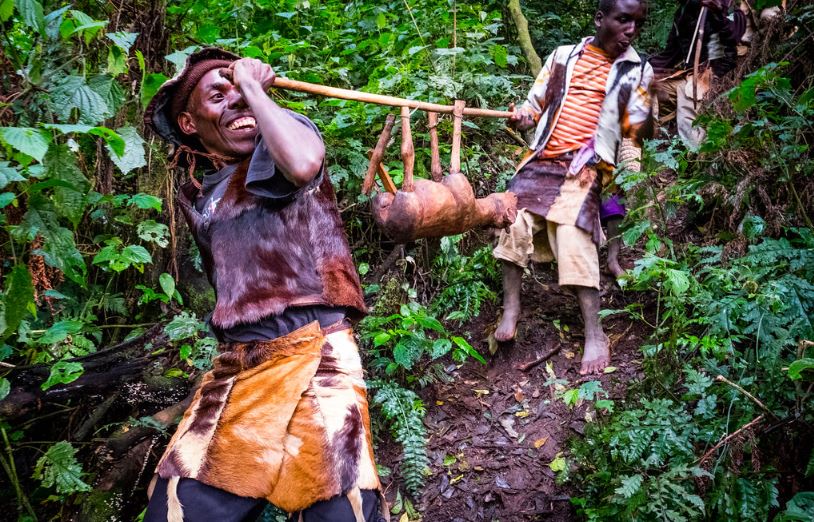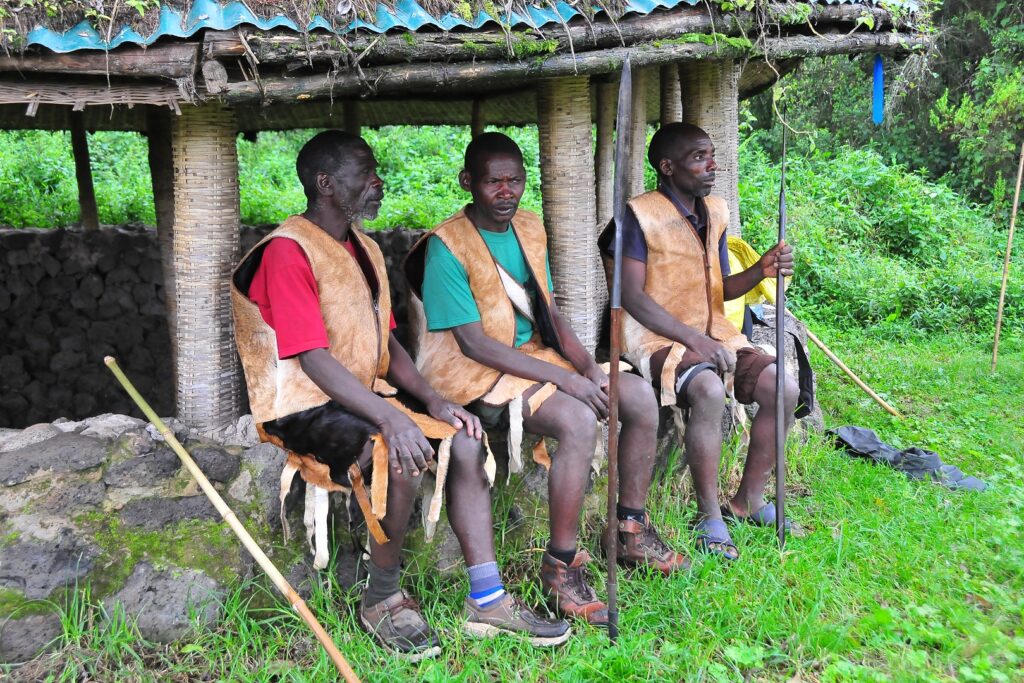The Batwa trail experience in Uganda : The Batwa trail experience in Uganda is considered to be one of the unique cultural tours that are conducted within the country led by various tour operators. And during this activity, tourists are always blessed with great opportunities to encounter with people from one of the famous ethnic tribes in Uganda and these are non-other than “the Batwa people”. Therefore, visitors will get chances to interact with them as they get to learn more about their way of lifestyle, traditions and customs, history and how they live in the present day.
The Batwa people who are also commonly referred to as the Batwa pygmies, are known to be original inhabitants of the Bwindi Impenetrable Forest. And basing from many stories, the Batwa people faced a lot of catastrophe a few years back as disinformation spread that sleeping with one of the pygmies could cure HIV/AIDS. Because they were ignorant of how to survive, the pygmies suffered greatly during this time and many of them perished. This is the main cause of the significant decline in the Batwa people’s population. Batwa people have survived all of the upheaval that the group has experienced, including being driven from the forests in 1991 and the HIV/AIDS pandemic.
What is the Batwa trail?
The paths through the forest that lead to the Batwa settlements and homesteads are referred to as the “Batwa trail.” The Batwa trails play a fantastic role in getting you up to speed with this prehistoric way of life of the African people, who lived in harmony with the local fauna in the densely forested areas of Africa many years ago. Long before mountain gorilla trekking became popular and the area was designated as a conservation area, the Batwa pygmies lived in the Bwindi Impenetrable Forest and Mgahinga Gorilla National Park. The Batwa trails in Bwindi, despite their brief duration, are connected to the Batwa cultural route in Mgahinga Gorilla National Park, where visitors can spend a whole day immersed in the Batwa way of life in the forest.
Uganda Wildlife Authority, which oversees Uganda’s national parks and protected areas, along with the Netherlands’ Embassy, launched the now-famous Batwa trail as a partial and important part of the rehabilitation and cultural preservation of the Batwa people in harmony with tourism, with funding from the United States Agency for International Development (USAID). The establishment of the Batwa Trail was, and continues to be, one method of ensuring that the Twa people live in harmony with their cultural roots and ancestry, as well as maintaining the authenticity of African culture, by freely imparting knowledge of their rich cultural heritage to visitors to Mgahinga Gorilla National Park and Bwindi Impenetrable National Park.
Who are the Batwa people?
The well-known Congo pygmies are called Batwa people, as was previously reported. The Twa, also known as the Batwa people, are a tiny ethnic group that lives in the dense forests of Uganda, Rwanda, and the Democratic Republic of the Congo’s Virunga conservation region. In the territories of Mgahinga National Park and Bwindi Impenetrable National Park, Batwa people are also recognized as the most ancient inhabitants.
Batwa people have persisted in being backward and clinging to their traditions and culture despite the world’s continued development and the spread of civilization. Until now, the Batwa people have survived on hunting and gathering fruits from Africa’s dense forests. The Batwa people have been able to thrive in the wild thanks to the forests of Congo and Bwindi Impenetrable National Park. The Batwa pygmies were driven from the Bwindi impenetrable forest, nevertheless, when mountain gorilla safaris were introduced in early 1991. This was the moment when Bwindi and Virunga National Parks were gazetted for the protection of the critically endangered mountain gorillas.
What to expect.
The Batwa people are indigenous people who are quite short, therefore there is a lot to expect from the Batwa Trail Forest Hiking Tour, including meeting some of the world’s shortest adult individuals. From the Batwa people’s perspective, you will see sincere affection for their forests and environments despite their height. You can see how much the Batwa people loved and still adore the forest when they tell stories of being forced out of it.
Visitors to the Batwa homesteads are offered the opportunity to engage in and participate in the customs of the two pygmies, such as food preparation, as they make their way through the forest and arrive at the Batwa community. They also learn a variety of skills, such as how to make a bush fire, hunt, make bamboo cups, and perform traditional Batwa dances. While almost all of the Batwa people’s activities are performed outside or in an open area inside the forest, the majority of their forest survival techniques, such fruit picking and hunting, are performed inside the forest.

The Batwa people will show you many additional types of herbs found in the forest as well as some beneficial medicinal tree properties. Along with learning how to harvest bee honey, fetch water using bamboo tubes, make fire by rubbing dry sticks, hunt, and construct huts, you can also accompany the Batwa hunters into the forest.
The women of the Batwa villages can play poignant and melancholic folk songs when you visit. The two women’s regretful songs reverberate throughout the dim cavern of the Garama Cave in the Mahinga National Park, where these performances take place. The impression of this rich, genuine, yet vanishing culture leaves people feeling touched and saddened. It’s an incredible experience.
You can also purchase tea or coffee from one of the batwa’s coffee shops; the batwa established these businesses as a means of subsistence after being driven out of the forest. You and your pals may decide to sip coffee while listening to the batwa people’s stories. Purchasing crafts made by women, such as baskets, hats, handbags, beads, and mats, is another way that you may help the Batwa villages.
Note: It is recommended that visitors to the Batwa communities purchase crafts and other goods created by the Batwa people. By doing this, you unintentionally support numerous families of these less advanced Batwa people living in the national parks of Bwindi and Mgahinga. The most crucial thing is to interact with the batwa, as this will provide you with a great opportunity to learn more about their intricate culture and how they coexist with wild creatures.
In summary, the batwa trail tour takes place in either Mgahinga National Park, where you can witness the garama pygmy cave, or Bwindi Impenetrable National Park, where the batwa people live outside the forest close to nearly all of the mountain gorilla trekking sections, including Buhoma, Ruhija, Nkuringo, and Rushaga. The batwa trail forest hikes are mainly done after the mountain gorilla trekking in Bwindi impenetrable national park and Mgahinga national park. You can request that your tour operator include the Batwa Trail in your schedule at all times. Keep in mind that helping the Batwa community survive is one of the most altruistic things you can do in Africa.
